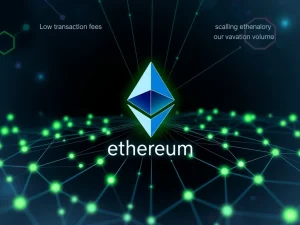Pioneering Grayscale Staking: Unlocking Revolutionary Crypto Yields for Wall Street

Wall Street and the crypto world have historically operated in separate spheres. Wall Street was known for traditional finance and clear regulatory norms. Conversely, the crypto industry grew around decentralized systems and evolving regulations. This divide is now narrowing significantly. The launch of the first publicly traded investment vehicle dedicated to crypto staking has made this possible. Grayscale Investments, a leading digital asset manager, introduced this staking-enabled exchange-traded product (ETP). It marks a new phase in crypto’s maturation. This product integrates digital assets with traditional finance. It serves as a crucial bridge. It offers traditional investors a regulated pathway. They can now access the growth potential of Grayscale staking. This article explores crypto staking and its institutional barriers. It discusses how Grayscale has driven the institutionalization of crypto investment. It also highlights regulatory and market changes. Finally, it explains how Grayscale’s spot crypto ETPs deliver staking yields to investors.
Grayscale Staking: A New Era for Institutional Investors
Grayscale has successfully bridged traditional finance and decentralized crypto. It launched the first publicly traded staking investment vehicle. Its staking-enabled ETPs allow investors to earn blockchain rewards. They do this without running validator nodes. They also avoid managing complex technical or custody risks. Grayscale’s Ether and Solana ETPs are groundbreaking. They are the first in the US to combine spot crypto exposure with staking rewards. These funds pay yields through the fund’s Net Asset Value (NAV) or direct payouts. This innovation transforms how mainstream investors engage with digital assets. It merges crypto rewards with traditional Wall Street exposure. The firm, founded in 2013, now manages over $35 billion in assets. This makes it one of the largest digital asset investment platforms globally.
Understanding Crypto Staking and Its Barriers
Crypto staking involves committing digital assets. Ether (ETH) or Solana (SOL) are common examples. These assets help secure and validate transactions on proof-of-stake (PoS) blockchains. Participants earn rewards in return. This concept is similar to earning interest. It supports network operations. Bitcoin’s proof-of-work (PoW) model relies on energy-intensive mining. PoS systems, however, operate differently. They depend on staked capital and validator performance. They do not rely on computing power. This design makes PoS systems far more energy-efficient. It also makes them accessible to a wider range of participants. Despite these benefits, both retail and institutional investors often focus on price gains. They buy and hold tokens rather than staking them. This hesitation stems from several challenges:
- Operational Complexity: Running validator nodes requires substantial capital. It also demands technical know-how and uninterrupted uptime.
- Risk Exposure: Participants face risks like slashing penalties. These occur for validator misbehavior. Custody challenges also exist.
- Regulatory Ambiguity: The regulatory treatment of staking rewards remains unclear in many jurisdictions. This uncertainty deters large-scale institutional participation.
For example, the first US Bitcoin futures exchange-traded fund (ETF), the ProShares Bitcoin Strategy ETF (BITO), launched on Oct. 19, 2021. It traded over $1 billion in volume on its first day. This showed strong demand for regulated crypto exposure, even without staking.
Bringing Wall Street Crypto to the Mainstream
Grayscale has played a central role in crypto’s institutionalization. Its new staking-enabled products integrate blockchain yield mechanics into Wall Street’s traditional framework. Grayscale offers regulated and user-friendly investment products. These products allow investors to gain exposure to cryptocurrencies. They eliminate the challenges of managing wallets, operating nodes, or dealing with validator risks. Through offerings like the Grayscale Ethereum Trust (ETHE) and Grayscale Solana Trust (GSOL), Grayscale integrates yield-generating features. It combines these with the regulatory and custodial standards of traditional finance. The firm uses trusted custodians. It also employs a diversified network of validator partners. Transparent reporting further builds confidence. Grayscale has established a secure and compliant way for investors to participate in staking. It transformed staking from a complex, retail-oriented process into a professional investment opportunity. This shift is crucial for wider adoption of Wall Street crypto.
The Rise of Regulated Staking in a Shifting Landscape
Grayscale’s introduction of staking-enabled funds marks a key milestone. This development is shaped by evolving oversight and growing market competition. The US Securities and Exchange Commission (SEC) issued guidance for crypto ETPs in May 2025. This guidance clarified that certain custodial staking activities could operate within existing securities laws. This applies when managed through regulated custodians and transparent structures. This development eased earlier barriers. It previously prevented ETFs from earning onchain rewards. Meanwhile, competition has intensified. Major players like BlackRock and Fidelity have entered the crypto ETF arena. This drives further innovation. In response, Grayscale rolled out staking-enabled ETPs. These blend yield generation with traditional fund frameworks. To enhance investor trust, Grayscale launched educational initiatives. For instance, “Staking 101: Secure the Blockchain, Earn Rewards” promotes transparency and understanding. This push for regulated staking signals a mature market. In 2025, Ether ETFs began allowing onchain staking. This allowed investors to earn yield without directly managing a crypto wallet.
How Grayscale Delivers Ethereum Staking Yields
The Grayscale Ethereum Trust (ETHE) and Grayscale Ethereum Mini Trust (ETH) are spot Ether ETPs. They now support onchain staking. The Grayscale Solana Trust (GSOL) also enabled staking while trading over the counter. These offerings are the first US-listed products. They combine spot crypto exposure with staking rewards. Each fund features a unique reward structure. ETHE pays staking rewards directly to investors. Conversely, ETH and GSOL incorporate rewards into the fund’s Net Asset Value (NAV). This gradually impacts share price. After deductions for custodian and sponsor fees, investors receive a net yield from validator rewards. Operationally, Grayscale uses institutional custodians. It also employs a diversified network of validator providers for passive staking. This configuration helps manage risks. These include slashing or downtime. It also supports liquidity. Clear disclosures, reporting, and adherence to regulatory frameworks enhance investor confidence. Grayscale staked 32,000 ETH (about $150 million) one day after enabling staking for its Ether ETPs. This made it the first US crypto fund issuer to offer staking-based passive income via US-listed spot products. This represents a significant step forward for Ethereum staking.
Risks and Criticisms of Grayscale’s Staking Funds
Regulatory uncertainty remains a key issue for staking-enabled products. Unlike fully registered ETFs under the Investment Company Act of 1940, Grayscale’s ETHE and ETH are structured as ETPs. These have different investor protections and disclosure requirements. GSOL, still traded over the counter, awaits regulatory approval for uplisting. This creates uncertainty about its long-term status and oversight. Future policy changes or stricter SEC enforcement could complicate the model. They might also limit staking within regulated funds. Operationally, risks such as validator performance, slashing events, and downtime persist. Balancing liquidity with staking lock-ups adds complexity. Ensuring fair, transparent distribution of rewards among shareholders also poses challenges. Market adoption presents another hurdle. It remains to be seen how staking-enabled ETPs perform against other Ether ETFs. Decentralization concerns are also significant. Institutional staking may enhance validator control. This could grant large funds outsized influence over governance and network security. This goes against the core principles of decentralization.
Transforming Crypto from Price Tracker to Income Generator
Grayscale’s staking-enabled ETPs have had a significant impact. This extends to Wall Street and the broader crypto ecosystem. These products connect blockchain-based yield with regulated financial products. They transform crypto ETPs from simple price trackers into income-generating assets. This initiative marks a key advance in institutional adoption. Regulated staking on Ethereum and Solana could attract substantial new capital. These networks might see significant inflows. This model could also apply to products linked to other PoS blockchains or tokenized assets. At the network level, institutional staking could enhance security and protocol stability. However, it may spark concerns about centralization. This could happen if large funds dominate validator roles. Such dominance might affect yields and governance balance. Grayscale’s staking-enabled ETPs will shape upcoming funds. They will influence standards for transparency, risk disclosures, taxation, and investor safeguards.
This article does not contain investment advice or recommendations. Every investment and trading move involves risk, and readers should conduct their own research when making a decision.









